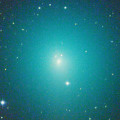
|
Now it is very bright as 6.0 mag (Apr. 7, Juan Jose Gonzalez). Now it is approaching to Earth down to 0.14 a.u. It is observable in excellent condition in the Northern Hemisphere. In the Southern Hemisphere, it is not be observable for about one month from late March to late April.
Date(TT) R.A. (2000) Decl. Delta r Elong. m1 Best Time(A, h)
Apr. 8 15 31.44 63 17.7 0.146 1.047 104 5.4 2:22 (180, 62)
Apr. 15 16 55.91 56 46.0 0.155 1.045 101 5.5 3:21 (180, 68)
|
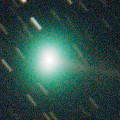
|
It brightened very rapidly. Now it is very bright as 6.7 mag (Apr. 5, Alan Hale). In the Northern Hemisphere, it stays observable in the morning sky until late April. In the Southern Hemisphere, it is already unobservable. But it will appear in the morning sky again at 13 mag in late June.
Date(TT) R.A. (2000) Decl. Delta r Elong. m1 Best Time(A, h)
Apr. 8 22 52.57 26 6.1 0.686 0.615 37 6.6 4:10 (251, 19)
Apr. 15 0 4.94 34 47.4 0.851 0.533 32 6.4 3:59 (237, 14)
|
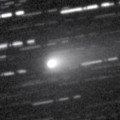
|
Outburst occured on Apr. 4, and it brightened by 2 mag. Now it is very bright as 6.2 mag (Apr. 7, Juan Jose Gonzalez). It stays observable for a long time after this. But it locates low in the Northern Hemisphere.
Date(TT) R.A. (2000) Decl. Delta r Elong. m1 Best Time(A, h)
Apr. 8 21 4.84 -13 31.1 1.199 1.170 63 7.6 4:10 (301, 17)
Apr. 15 21 39.78 -10 8.3 1.181 1.123 61 7.4 3:59 (295, 16)
|
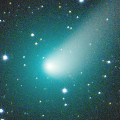
|
Now it is 9.2 mag (Apr. 7, Juan Jose Gonzalez). It was expected to brighten up to 6-7 mag from April to July. But it is fainter than predicted recently. In the Northern Hemisphere, it stays observable in excellent condition until June. In the Southern Hemisphere, it stays extremely low for a while.
Date(TT) R.A. (2000) Decl. Delta r Elong. m1 Best Time(A, h)
Apr. 8 16 27.53 47 31.6 1.258 1.854 109 8.2 3:23 (180, 78)
Apr. 15 16 20.69 47 6.1 1.179 1.813 112 7.9 2:49 (180, 78)
|
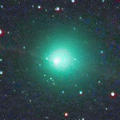
|
Now it is fading rapidly. It has already faded down to 9.8 mag (Apr. 5, Chris Wyatt). In the Southern Hemisphere, it stays observable after this while the comet will be fading. In the Northern Hemisphere, it stays unobservable until May when it becomes fainter than 14 mag.
Date(TT) R.A. (2000) Decl. Delta r Elong. m1 Best Time(A, h)
Apr. 8 22 34.54 -18 10.3 0.995 0.769 45 10.5 4:10 (290, -2)
Apr. 15 22 38.80 -17 57.8 1.065 0.892 51 11.7 3:59 (292, 0)
|
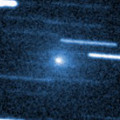
|
Now it is 10.9 mag (Apr. 5, Chris Wyatt). It stays 10-11 mag until May. In the Southern Hemisphere, it stays observable for a long time, but it stays low. It will not be observable soon in the Northern Hemisphere. Juan Jose Gonzalez reported it is very bright as 7.9 mag on Apr. 7.
Date(TT) R.A. (2000) Decl. Delta r Elong. m1 Best Time(A, h)
Apr. 8 22 32.69 -3 60.0 1.396 0.901 40 10.5 4:10 (279, 6)
Apr. 15 23 7.30 -2 21.9 1.448 0.904 38 10.6 3:59 (276, 4)
|

|
It has not been observed yet in this apparition. The condition of this apparition is worst. It will brighten up to 10 mag in spring, but not observable at all.
Date(TT) R.A. (2000) Decl. Delta r Elong. m1 Best Time(A, h)
Apr. 8 1 21.51 10 18.3 2.074 1.080 4 11.5 19:53 (113,-13)
Apr. 15 1 50.83 12 3.7 2.064 1.069 5 11.3 20:01 (115,-13)
|
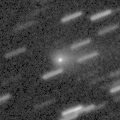
|
Now it is 15.0 mag (Apr. 2, Kunihiro Shima). It is expected to brighten up to 10 mag in summer. But actually, it is much fainter than this ephemeris recently. It will be observable in excellent condition in the Southern Hemisphere. It locates low in the Northern Hemisphere.
Date(TT) R.A. (2000) Decl. Delta r Elong. m1 Best Time(A, h)
Apr. 8 16 26.45 -16 18.2 0.947 1.769 130 12.7 3:22 ( 0, 39)
Apr. 15 16 32.47 -17 16.8 0.877 1.742 135 12.3 3:00 ( 0, 38)
|
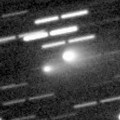
|
Now it is 11.9 mag (Apr. 1, Andrew Pearce). Bright new fragment BT was discovered on Feb. 10. Now the fragment BT is fainter than the primary component. In the Southern Hemisphere, it stays observable for a long time after this. In the Northern Hemisphere, it is not observable temporarily until mid June.
Date(TT) R.A. (2000) Decl. Delta r Elong. m1 Best Time(A, h)
Apr. 8 22 44.57 -13 56.5 1.537 1.023 41 12.5 4:10 (286, -2)
Apr. 15 23 11.50 -11 57.1 1.581 1.058 41 12.8 3:59 (283, -3)
|

|
Now it is 15.7 mag (Apr. 1, Kunihiro Shima). It locates high in the Southern Hemisphere.
Date(TT) R.A. (2000) Decl. Delta r Elong. m1 Best Time(A, h)
Apr. 8 21 23.96 -15 39.8 6.294 5.853 59 13.8 4:10 (299, 12)
Apr. 15 21 27.72 -15 17.6 6.195 5.851 65 13.7 3:59 (301, 15)
|
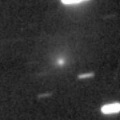
|
Now it is bright as 14.4 mag (Jan. 14, Thomas Lehmann). It is not observable now in the Northern Hemisphere. It will be unobservable temporarily in May also in the Southern Hemisphere. It will be getting higher gradually in the morning sky after summer. Then it will be observable at 11 mag for a long time from 2017 autumn to 2018 winter.
Date(TT) R.A. (2000) Decl. Delta r Elong. m1 Best Time(A, h)
Apr. 8 3 18.24 -18 13.7 5.428 4.720 41 14.4 19:53 ( 73, -7)
Apr. 15 3 23.65 -17 1.7 5.414 4.668 38 14.4 20:01 ( 78,-12)
|
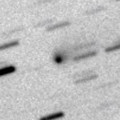
|
Now it is 15.8 mag (Apr. 2, Kunihiro Shima). It will brighten up to 14 mag from spring to summer. It locates somewhat low in the Northern Hemisphere. The perihelion distance increased from 2.4 a.u. to 2.9 a.u. in this apparition. So it will not be bright as before.
Date(TT) R.A. (2000) Decl. Delta r Elong. m1 Best Time(A, h)
Apr. 8 16 31.44 -20 16.6 2.333 3.061 128 14.5 3:27 ( 0, 35)
Apr. 15 16 30.76 -20 30.4 2.250 3.051 135 14.4 2:59 ( 0, 34)
|
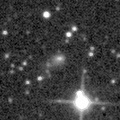
|
Now it is 15.9 mag (Mar. 30, Kunihiro Shima). It will be observable at 13 mag for a long time from 2017 to 2018.
Date(TT) R.A. (2000) Decl. Delta r Elong. m1 Best Time(A, h)
Apr. 8 19 8.72 6 53.7 4.557 4.643 88 14.8 4:10 (310, 52)
Apr. 15 19 6.05 8 19.0 4.410 4.608 95 14.7 3:59 (315, 56)
|
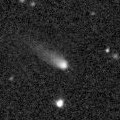
|
Now it is 15.6 mag (Feb. 15, Alexander Baransky). It will brighten up to 12-13 mag and will be observable in good condition in summer. Now it is not observable. It will appear in the morning sky in May.
Date(TT) R.A. (2000) Decl. Delta r Elong. m1 Best Time(A, h)
Apr. 8 0 17.98 13 50.8 4.056 3.093 13 14.9 4:10 (250, -4)
Apr. 15 0 19.44 14 3.9 3.995 3.060 18 14.8 3:59 (252, -1)
|
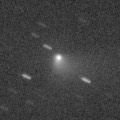
|
Small outburst occured in mid March. Now it is 14.6 mag (Mar. 26, Sandor Szabo). It is observable in excellent condition in the Northern Hemisphere. It stays low in the Southern Hemisphere.
Date(TT) R.A. (2000) Decl. Delta r Elong. m1 Best Time(A, h)
Apr. 8 11 33.23 30 59.6 1.791 2.604 135 14.9 22:25 ( 0, 86)
Apr. 15 11 30.92 30 5.1 1.858 2.624 130 15.0 21:56 ( 0, 85)
|

|
It has not been observed yet in this apparition. It will brighten up to 12 mag in summer. It will be observable in excellent condition in the Southern Hemisphere. It locates somewhat low in the Northern Hemisphere.
Date(TT) R.A. (2000) Decl. Delta r Elong. m1 Best Time(A, h)
Apr. 8 18 45.63 -33 23.1 1.991 2.354 98 15.1 4:10 (340, 18)
Apr. 15 18 55.16 -33 24.1 1.886 2.328 103 14.9 3:59 (342, 19)
|
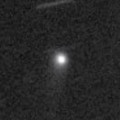
|
Now it is not observable. In the Northern Hemisphere, it will appear in the morning sky in late April. Then it will brighten up to 14 mag from summer to next winter, and it will be observable in excellent condition. In the Southern Hemisphere, it will be observable in the very low sky only from May to June.
Date(TT) R.A. (2000) Decl. Delta r Elong. m1 Best Time(A, h)
Apr. 8 23 51.61 14 54.1 4.474 3.550 20 15.3 4:10 (253, 1)
Apr. 15 23 56.88 16 42.5 4.412 3.522 24 15.2 3:59 (253, 5)
|
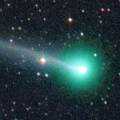
|
It approached to Earth down to 0.08 a.u. in mid February, and brightened up to 6.5 mag (Feb. 10, Danil Sidorko). Now it is fading rapidly. It has already faded down to 11.2 mag (Mar. 19, Osamu Miyazaki).
Date(TT) R.A. (2000) Decl. Delta r Elong. m1 Best Time(A, h)
Apr. 8 10 32.53 18 15.1 0.872 1.727 134 15.3 21:25 ( 0, 73)
Apr. 15 10 34.79 17 11.7 1.007 1.811 128 15.9 21:00 ( 0, 72)
|

|
Now it is 15.6 mag (Mar. 6, Kunihiro Shima). Now it is not observable. But it will appear in the morning sky in June in the Southern Hemisphere, or in July in the Northern Hemisphere. Then it stays observable at 15.5 mag unil the end of 2017.
Date(TT) R.A. (2000) Decl. Delta r Elong. m1 Best Time(A, h)
Apr. 8 1 56.39 1 34.8 6.356 5.388 13 15.3 19:53 (101,-12)
Apr. 15 2 2.80 2 1.6 6.391 5.409 10 15.4 20:01 (105,-17)
|
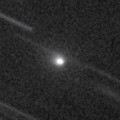
|
Now it is 14.9 mag (Mar. 26, Sandor Szabo). It stays 15 mag until spring. But it is already unobservable in the Southern Hemisphere. It will be getting lower gradually after this also in the Northern Hemisphere.
Date(TT) R.A. (2000) Decl. Delta r Elong. m1 Best Time(A, h)
Apr. 8 3 20.78 27 25.0 2.425 1.744 37 15.5 19:53 (111, 20)
Apr. 15 3 42.44 28 26.7 2.474 1.761 35 15.7 20:01 (113, 18)
|
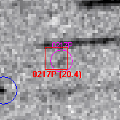
|
It will brighten rapidly, and it is expected to brighten up to 12 mag from July to September. In the Southern Hemisphere, it stays at the same altitude in the morning sky. In the Northern Hemisphere, it will be getting higher slowly.
Date(TT) R.A. (2000) Decl. Delta r Elong. m1 Best Time(A, h)
Apr. 8 21 54.15 -11 39.3 2.169 1.732 51 15.9 4:10 (291, 9)
Apr. 15 22 14.42 -10 27.1 2.073 1.678 53 15.6 3:59 (290, 9)
|

|
Now it is 15.7 mag (Mar. 26, Sandor Szabo). It stays 16-17 mag for a long time from 2016 to 2019. It stays near by the equator.
Date(TT) R.A. (2000) Decl. Delta r Elong. m1 Best Time(A, h)
Apr. 8 9 4.87 5 37.7 9.080 9.596 118 15.9 19:58 ( 0, 61)
Apr. 15 9 5.09 5 53.7 9.178 9.592 111 16.0 20:01 ( 15, 60)
|
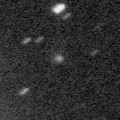
|
Now it is 17.0 mag (Mar. 2, Thomas Lehmann). It is expected to brighten up to 9 mag in summer in 2018. In the Northern Hemisphere, it stays observable until 2018 summer while the comet will be brightening. In the Southern Hemisphere, it is hardly observable in 2017, but it will be observable in good condition in 2018.
Date(TT) R.A. (2000) Decl. Delta r Elong. m1 Best Time(A, h)
Apr. 8 19 12.62 49 32.8 5.485 5.466 83 16.1 4:10 (227, 64)
Apr. 15 19 12.14 50 16.7 5.390 5.410 85 16.0 3:59 (222, 66)
|

|
It brightened up to 11 mag from spring to summer in 2016. Now it is 16.8 mag (Apr. 2, Kunihiro Shima). It will be observable at 16-17 mag in good condition from spring to summer.
Date(TT) R.A. (2000) Decl. Delta r Elong. m1 Best Time(A, h)
Apr. 8 20 12.52 -18 4.3 2.838 2.786 76 16.0 4:10 (314, 22)
Apr. 15 20 18.58 -17 44.6 2.782 2.826 82 16.1 3:59 (316, 24)
|

|
Now it is 16.6 mag (Mar. 30, Kunihiro Shima). It stays observable at 16 mag until June. It locates low in the Southern Hemisphere.
Date(TT) R.A. (2000) Decl. Delta r Elong. m1 Best Time(A, h)
Apr. 8 6 57.56 27 16.7 3.633 3.679 84 16.1 19:53 ( 82, 63)
Apr. 15 7 2.87 27 7.2 3.728 3.672 79 16.2 20:01 ( 87, 57)
|
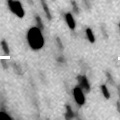
|
Now it is 17.3 mag (Mar. 3, T. Ikemura, H. Sato). It was observed at 16 mag from spring to summer in 2016. It will be observable at 16 mag also in 2017 from winter to spring.
Date(TT) R.A. (2000) Decl. Delta r Elong. m1 Best Time(A, h)
Apr. 8 18 23.80 7 45.0 3.105 3.417 99 16.1 4:10 (326, 58)
Apr. 15 18 26.08 9 50.3 3.051 3.441 104 16.2 3:59 (330, 62)
|
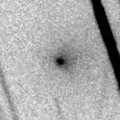
|
Small comet, but it approached to Sun down to 0.9 a.u., and to Earth down to 0.5 a.u. It brightened very rapidly, and brightened up to 10.7 mag in late February (Feb. 24, Juan Jose Gonzalez). It is fading very rapidly after that. It has already faded down to 18.7 mag (Mar. 29, Kunihiro Shima). It is observable in excellent condition in the Northern Hemisphere. In the Southern Hemisphere, it is not observable after this.
Date(TT) R.A. (2000) Decl. Delta r Elong. m1 Best Time(A, h)
Apr. 8 6 52.23 77 11.4 0.533 1.069 82 16.2 19:53 (171, 46)
Apr. 15 10 1.63 75 46.8 0.550 1.136 89 17.3 20:37 (180, 50)
|

|
It brightened up to 6.2 mag in June in 2016 (June 24, Marco Goiato). Now it is fading. But recently, it is bright as 15.6 mag (Apr. 2, Kunihiro Shima). In the Southern Hemisphee, it stays observable in excellent condition after this. It stays low in the Northern Hemisphere.
Date(TT) R.A. (2000) Decl. Delta r Elong. m1 Best Time(A, h)
Apr. 8 13 38.73 -32 45.6 3.620 4.537 153 16.4 0:35 ( 0, 22)
Apr. 15 13 27.49 -31 48.3 3.660 4.604 157 16.4 23:51 ( 0, 23)
|

|
It stayed bright 12 mag for a long time from autum in 2015 to summer in 2016. Now it is fading. It has already faded dwon to 16.2 mag (Apr. 1, Kunihiro Shima).
Date(TT) R.A. (2000) Decl. Delta r Elong. m1 Best Time(A, h)
Apr. 8 17 17.48 -8 48.1 4.154 4.708 117 16.5 4:10 (359, 46)
Apr. 15 17 13.59 -9 12.9 4.106 4.759 125 16.6 3:42 ( 0, 46)
|
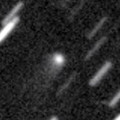
|
Now it is 16.2 mag (Mar. 26, Sandor Szabo). It stays 16 mag for a long time from 2017 to 2018.
Date(TT) R.A. (2000) Decl. Delta r Elong. m1 Best Time(A, h)
Apr. 8 8 19.87 5 34.4 5.214 5.594 107 16.6 19:53 ( 20, 59)
Apr. 15 8 17.86 6 40.2 5.317 5.578 99 16.6 20:01 ( 37, 57)
|

|
Now it is 16.2 mag (Apr. 2, Kunihiro Shima). It stays 16.5 mag from 2016 to 2017. In the Northern Hemisphere, it stays observable in good condition for a long time. In the Southern Hemisphere, it will never be observable again.
Date(TT) R.A. (2000) Decl. Delta r Elong. m1 Best Time(A, h)
Apr. 8 19 0.69 52 8.3 6.299 6.297 85 16.6 4:10 (219, 65)
Apr. 15 19 2.56 53 38.2 6.282 6.303 86 16.6 3:59 (213, 66)
|

|
Now it is 17.3 mag (Mar. 6, iTelescope Observatory, Siding Spring). It will brighten up to 15.5 mag in summer. It will be observable in excellent condition in the Southern Hemisphere. In the Northern Hemisphere, it stays unobservable for some more time.
Date(TT) R.A. (2000) Decl. Delta r Elong. m1 Best Time(A, h)
Apr. 8 20 42.06 -45 23.8 2.707 2.698 78 17.0 4:10 (326, -3)
Apr. 15 20 55.59 -44 43.8 2.608 2.670 82 16.8 3:59 (326, -2)
|

|
It has not been recovered yet in this apparition. It will brighten rapidly, and it is expected to be observable at 15.5 mag in good condition from July to September.
Date(TT) R.A. (2000) Decl. Delta r Elong. m1 Best Time(A, h)
Apr. 8 22 41.45 -26 12.7 3.173 2.620 48 17.1 4:10 (296, -8)
Apr. 15 22 54.52 -25 3.9 3.103 2.605 51 17.0 3:59 (296, -7)
|
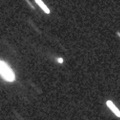
|
Now it is 16.2 mag (Mar. 30, Kunihiro Shima). It brightened rapidly, and became brighter than originally expected. It stays 16-17 mag until 2017. In the Northern Hemisphere, it stays observable in excellent condition for a long time. It is not observable in the Southern Hemisphere.
Date(TT) R.A. (2000) Decl. Delta r Elong. m1 Best Time(A, h)
Apr. 8 12 6.93 60 48.1 7.019 7.438 111 17.1 22:58 (180, 64)
Apr. 15 11 57.76 60 16.4 7.083 7.447 107 17.1 22:22 (180, 65)
|
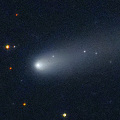
|
It brightened up to 11-12 mag from summer to autumn in last year. Now it is fading. It has already faded down to 16.0 mag (Mar. 30, Kunihiro Shima).
Date(TT) R.A. (2000) Decl. Delta r Elong. m1 Best Time(A, h)
Apr. 8 11 40.20 -21 51.5 1.697 2.635 154 17.1 22:32 ( 0, 33)
Apr. 15 11 36.09 -20 29.1 1.766 2.682 149 17.4 22:01 ( 0, 35)
|

|
It has not been observed since last April. Now it is fading. But it must be bright as 17 mag still now.
Date(TT) R.A. (2000) Decl. Delta r Elong. m1 Best Time(A, h)
Apr. 8 17 9.55 -18 25.8 2.606 3.225 120 17.2 4:05 ( 0, 37)
Apr. 15 17 7.47 -17 59.8 2.590 3.296 127 17.2 3:36 ( 0, 37)
|
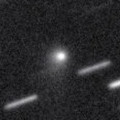
|
It brightened up to 15 mag in early 2016. Now it is fading. It has already faded down to 17.1 mag (Mar. 3, K. Hills). In the Northern Hemisphere, it stays observable in good condition for a long time until autumn when the comet will be fainter than 18 mag. It will never be observable after this in the Southern Hemisphere.
Date(TT) R.A. (2000) Decl. Delta r Elong. m1 Best Time(A, h)
Apr. 8 14 49.88 72 15.0 6.352 6.581 98 17.2 1:45 (180, 53)
Apr. 15 14 38.72 72 7.7 6.406 6.612 97 17.2 1:07 (180, 53)
|
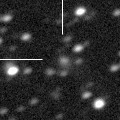
|
Now it is 17.0 mag (Mar. 13, E. Primucci). In the Southern Hemisphere, it is observable at 17 mag in good condition in spring. It stays extremely low in the Northern Hemisphere.
Date(TT) R.A. (2000) Decl. Delta r Elong. m1 Best Time(A, h)
Apr. 8 12 54.81 -44 18.6 5.058 5.886 142 17.2 23:47 ( 0, 11)
Apr. 15 12 51.27 -43 18.3 5.037 5.888 145 17.2 23:16 ( 0, 12)
|
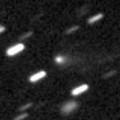
|
Now it is 17.0 mag (Mar. 2, Kunihiro Shima). It is observable in excellent condition in the Northern Hemisphere. It locates low in the Southern Hemisphere.
Date(TT) R.A. (2000) Decl. Delta r Elong. m1 Best Time(A, h)
Apr. 8 7 5.56 30 51.3 3.484 3.559 86 17.3 19:53 ( 88, 66)
Apr. 15 7 12.11 30 23.1 3.595 3.574 80 17.4 20:01 ( 91, 60)
|
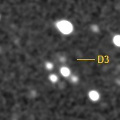
|
Now it is 17.1 mag (Mar. 7, iTelescope Observatory, Siding Spring). It is observable at 17.5 mag in good condition in spring. It locates somewhat low in the Northern Hemisphere.
Date(TT) R.A. (2000) Decl. Delta r Elong. m1 Best Time(A, h)
Apr. 8 12 37.64 -27 43.6 4.026 4.970 158 17.5 23:29 ( 0, 27)
Apr. 15 12 29.70 -25 55.9 4.025 4.969 157 17.5 22:54 ( 0, 29)
|
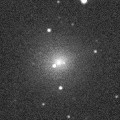
|
It brightened up to 11-12 mag in autumn. Now it is fading. It has already faded down to 16.9 mag (Mar. 3, T. Ikemura, H. Sato).
Date(TT) R.A. (2000) Decl. Delta r Elong. m1 Best Time(A, h)
Apr. 8 13 24.96 -13 48.7 1.640 2.635 171 17.6 0:21 ( 0, 41)
Apr. 15 13 18.43 -12 60.0 1.682 2.683 175 17.8 23:42 ( 0, 42)
|
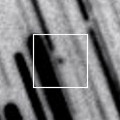
|
It will be observable at 17.5 mag in good condition from April to May.
Date(TT) R.A. (2000) Decl. Delta r Elong. m1 Best Time(A, h)
Apr. 8 18 6.91 -6 48.1 1.939 2.410 105 17.8 4:10 (341, 46)
Apr. 15 17 51.82 -8 4.9 1.821 2.434 116 17.7 3:59 (352, 47)
|
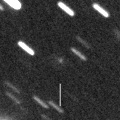
|
It stays at 14 mag for a long time from 2018 to 2019. In the Northern Hemisphere, it stays observable in good condition while the comet will be brightening gradually. In the Southern Hemisphere, it is not observable until 2018 October.
Date(TT) R.A. (2000) Decl. Delta r Elong. m1 Best Time(A, h)
Apr. 8 18 30.59 47 37.4 5.137 5.248 90 17.8 4:10 (222, 71)
Apr. 15 18 27.66 49 25.7 5.046 5.196 92 17.7 3:59 (211, 72)
|
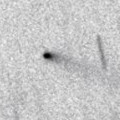
|
Now it is 18.0 mag (Mar. 28, Kunihiro Shima). It was observed at 17 mag in early 2016 and early 2017. It will be fainter than 18 mag in May. It is observable in good condition in the Northern Hemisphere. But it locates low in the Southern Hemisphere.
Date(TT) R.A. (2000) Decl. Delta r Elong. m1 Best Time(A, h)
Apr. 8 10 56.51 42 23.3 3.686 4.305 122 17.7 21:49 (180, 83)
Apr. 15 10 54.93 42 43.1 3.795 4.336 116 17.8 21:20 (180, 82)
|
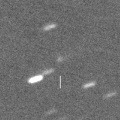
|
Now it is 17.9 mag (Mar. 30, Kunihiro Shima). It will be fainter than 18 mag in May.
Date(TT) R.A. (2000) Decl. Delta r Elong. m1 Best Time(A, h)
Apr. 8 15 5.39 -11 32.2 1.566 2.486 150 17.8 2:01 ( 0, 43)
Apr. 15 15 1.06 -11 24.0 1.547 2.506 158 17.9 1:30 ( 0, 44)
|
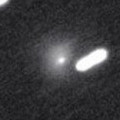
|
Very far object. Outburst occured on Feb. 20, 2015, and it brightened up to 15 mag. Now it is 18.3 mag (Mar. 30, Kunihiro Shima). It is observable in excellent condition in the Southern Hemisphere. It locates low in the Northern Hemisphere.
Date(TT) R.A. (2000) Decl. Delta r Elong. m1 Best Time(A, h)
Apr. 8 14 38.17 -26 19.7 8.498 9.386 150 17.9 1:34 ( 0, 29)
Apr. 15 14 36.35 -26 8.7 8.456 9.392 157 17.9 1:05 ( 0, 29)
|
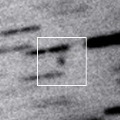
|
It stays observable at 18 mag from spring to summer. It is observable in excellent condition in the Southern Hemisphere. In the Northern Hemisphere, it stays unobservable for some more time.
Date(TT) R.A. (2000) Decl. Delta r Elong. m1 Best Time(A, h)
Apr. 8 22 0.60 -35 46.6 5.623 5.216 61 17.9 4:10 (309, -7)
Apr. 15 22 6.25 -35 22.0 5.555 5.232 66 17.9 3:59 (310, -5)
|
|
![]()
 71P/Clark
71P/Clark 73P/Schwassmann-Wachmann 3
73P/Schwassmann-Wachmann 3 29P/Schwassmann-Wachmann 1
29P/Schwassmann-Wachmann 1 C/2016 R2 ( PanSTARRS )
C/2016 R2 ( PanSTARRS ) 65P/Gunn
65P/Gunn C/2015 O1 ( PanSTARRS )
C/2015 O1 ( PanSTARRS ) C/2015 VL62 ( Lemmon-Yeung-PanSTARRS )
C/2015 VL62 ( Lemmon-Yeung-PanSTARRS ) 315P/2013 V6 ( LONEOS )
315P/2013 V6 ( LONEOS ) 213P/Van Ness
213P/Van Ness C/2016 N4 ( MASTER )
C/2016 N4 ( MASTER ) 45P/Honda-Mrkos-Pajdusakova
45P/Honda-Mrkos-Pajdusakova C/2011 KP36 ( Spacewatch )
C/2011 KP36 ( Spacewatch ) 93P/Lovas 1
93P/Lovas 1 217P/LINEAR
217P/LINEAR C/2014 B1 ( Schwartz )
C/2014 B1 ( Schwartz ) C/2016 M1 ( PanSTARRS )
C/2016 M1 ( PanSTARRS ) 81P/Wild 2
81P/Wild 2 74P/Smirnova-Chernykh
74P/Smirnova-Chernykh C/2016 B1 ( NEOWISE )
C/2016 B1 ( NEOWISE ) C/2016 VZ18 ( PanSTARRS )
C/2016 VZ18 ( PanSTARRS ) C/2013 X1 ( PanSTARRS )
C/2013 X1 ( PanSTARRS ) C/2014 W2 ( PanSTARRS )
C/2014 W2 ( PanSTARRS ) C/2016 A1 ( PanSTARRS )
C/2016 A1 ( PanSTARRS ) C/2014 OE4 ( PanSTARRS )
C/2014 OE4 ( PanSTARRS ) C/2017 D2 ( Barros )
C/2017 D2 ( Barros ) P/2000 S1 ( Skiff )
P/2000 S1 ( Skiff ) C/2014 R3 ( PanSTARRS )
C/2014 R3 ( PanSTARRS ) 43P/Wolf-Harrington
43P/Wolf-Harrington C/2015 TQ209 ( LINEAR )
C/2015 TQ209 ( LINEAR ) C/2013 V4 ( Catalina )
C/2013 V4 ( Catalina ) C/2017 E3 ( PanSTARRS )
C/2017 E3 ( PanSTARRS ) P/2015 TP200 ( LINEAR )
P/2015 TP200 ( LINEAR ) C/2017 D3 ( ATLAS )
C/2017 D3 ( ATLAS ) 144P/Kushida
144P/Kushida C/2016 T1 ( Matheny )
C/2016 T1 ( Matheny ) C/2016 N6 ( PanSTARRS )
C/2016 N6 ( PanSTARRS ) C/2015 X7 ( ATLAS )
C/2015 X7 ( ATLAS ) 94P/Russell 4
94P/Russell 4 C/2013 C2 ( Tenagra )
C/2013 C2 ( Tenagra ) C/2015 H2 ( PanSTARRS )
C/2015 H2 ( PanSTARRS )![]()










































